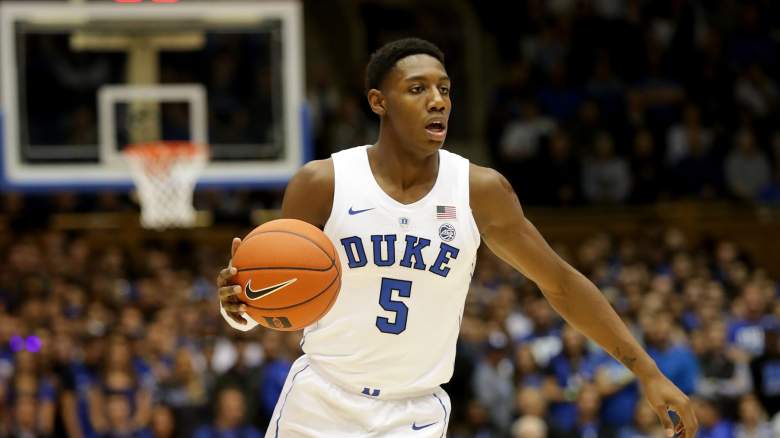
Duke freshman swingman R.J. Barrett has quickly established himself as one of the best players in college basketball. He has the potential to be a high-volume scorer and above-average defender on the next level. While I’m not sure he is a superstar in the NBA, I’ve seen enough to believe he could be a near 20-point-per-game guy relatively early in his pro career.
Here is a breakdown of his strengths, weaknesses and an NBA Player Comparison.
Date of Birth: June 16, 2000
Height: 6’7″
Weight: 202 pounds
Wingspan: 6’10”
College Team: Duke
NBA Position(s): SG/SF
Strengths
Length
It’s possible he’s grown since he measured at 6’6.5″ with a 6’10” wingspan in April 2017, but even if he hasn’t, he has near ideal length for an NBA swingman. He helps to accentuate his length with his long strides and ability to move the ball while driving to the rim. It’s part of the reason he’s so dangerous off the bounce. The length can also serve him well on the defensive end. When he’s locked in, he can be a terror capable of guarding three or four positions–especially in the small-ball era where teams use stretch-4s.
Play Initiator Potential
Barrett has the requisite handle and vision to be a point-forward or 2-guard that a coach can run his offense through. He has an array of change of direction moves and the touch on passes to setup shooters and bigs who are working off pick and roll.
Confidence
Some players play the game with seemingly unshakeable confidence and Barrett is one of those guys. In this way, he reminds me a lot of the Brooklyn Nets’ D’Angelo Russell. The two aren’t that much different athletically, though Barrett has an edge in bounce and length.
Weaknesses
Not Overly Explosive
Speaking of Barrett’s athleticism; while he might be bouncier than Russell, he’s still not an elite athlete at the swingman position. He’s not so slow that he’s a liability on defense, but he’s not a spectacular run-jump athlete like DeMar DeRozan or Andrew Wiggins.
Inconsistent Finisher at the Rim
Because Barrett doesn’t have a ton of explosion, he can struggle to finish at the rim. Through November, he was only converting on 56.2% of his shots at the rim. That’s a pretty low number for a player who has the rest of Barrett’s tools and skills. He needs to master the floater and some mid-range shots to improve his efficiency inside the three-point line.
Below-Average FT Shooter
Because of his handle and ability to change speeds off the dribble, Barrett has the potential to draw tons of fouls. The only problem–at least up to now–is that he’s a below-average free throw shooter. He’s shooting five free throws per game and only making 61 percent of them. If you look at the top 20 scorers in the NBA this season, all of them are shooting at least 70 percent from the line with the exception of one guy, and that’s the Milwaukee Bucks’ Giannis Antetokounmpo. It’s safe to say, Barrett doesn’t possess the freakish athletic and physical gifts that make Antetokounmpo a legitimate MVP candidate. To maximize his potential as a scorer, Barrett will need to improve his FT shooting.
Player Comparison: Slightly More Athletic Khris Middleton
Middleton might be one of the league’s most underrated players. This season Middleton is averaging 18.5 points, 4.5 assists and 5.5 rebounds per game. Middleton is a career 39% three-point shooter and he makes about 88 percent of his free throws. Barrett is only 19 years old, so he’s far from a finished product. With fine tuning on his shot mechanics and shot selection, I can see him becoming a similar player.
Comments
R.J. Barrett Early Scouting Report: Strengths, Weaknesses And NBA Player Comparison